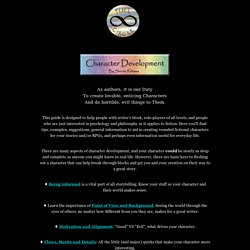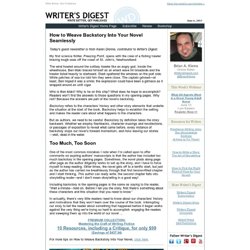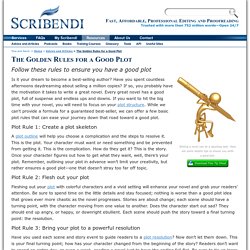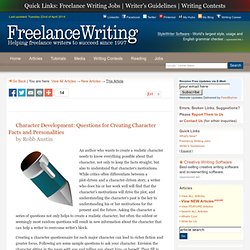

Character Chart for Fiction Writers - EpiGuide.com. If you're a fiction writer -- whether you're working on a novel, short story, screenplay, television series, play, web series, webserial, or blog-based fiction -- your characters should come alive for your reader or audience. The highly detailed chart below will help writers develop fictional characters who are believable, captivating, and unique. Print this page to complete the form for each main character you create. IMPORTANT: Note that all fields are optional and should be used simply as a guide; character charts should inspire you to think about your character in new ways, rather than constrain your writing. Fill in only as much info as you choose.
How to Structure A Story: The Eight-Point Arc. By Ali Hale - 3 minute read One of my favourite “how to write” books is Nigel Watts’ Writing A Novel and Getting Published. My battered, torn and heavily-pencil-marked copy is a testament to how useful I’ve found it over the years. Although the cover appears to be on the verge of falling off altogether, I’ve risked opening the book once more to bring you Watts’ very useful “Eight-Point Story Arc” – a fool-proof, fail-safe and time-honoured way to structure a story. (Even if you’re a short story writer or flash fiction writer rather than a novelist, this structure still applies, so don’t be put off by the title of Watts’ book.)
The eight points which Watts lists are, in order: StasisTriggerThe questSurpriseCritical choiceClimaxReversalResolution He explains that every classic plot passes through these stages and that he doesn’t tend to use them to plan a story, but instead uses the points during the writing process: So, what do the eight points mean? Stasis Trigger The quest Surprise Climax Reversal. The Art of Character Development. As authors, it is our Duty To create lovable, enticing Characters And do horrible, evil things to Them.

This guide is designed to help people with writer's block, role-players of all levels, and people who are just interested in psychology and philosophy as it applies to fiction. Here you'll find tips, examples, suggestions, general information to aid in creating rounded fictional characters for your stories and/or RPGs, and perhaps even information useful for everyday life. There are many aspects of character development, and your character could be nearly as deep and complete as anyone you might know in real life. However, there are basic keys to fleshing out a character that can help break through blocks and get you and your creation on their way to a great story. ♦ Being informed is a vital part of all storytelling.
. ♦ Learn the importance of Point of View and Background. . ♦ Motivation and Alignment: "Good" VS "Evil", what drives your character. The characters come before the story. 25 Ways To Fuck With Your Characters. As storyteller, you are god.

And to be frank, you’re not a particularly nice god — at least, not if you want your story to resonate with readers. A good storyteller is a crass and callous deity who treats the characters under his watchful eye like a series of troubled butt-puppets. From this essential conflict — storyteller versus character — a story is born. Back story. How to Weave Backstory Into Your Novel Seamlessly Today's guest newsletter is from Karen Dionne, contributor to Writer's Digest.

My first science thriller, Freezing Point , opens with the crew of a fishing trawler braving rough seas off the coast of St. John’s, Newfoundland: The wind howled around the solitary trawler like an angry god. Inside the wheelhouse, Ben Maki braced himself as an errant wave hit broadside and the trawler listed heavily to starboard. Who is Ben Maki? Backstory refers to the characters’ history and other story elements that underlie the situation at the start of the book.
But as authors, we need to be careful: Backstory by definition takes the story backward. Too Much, Too Soon One of the most common mistakes I note when I’m called upon to offer comments on aspiring authors’ manuscripts is that the author has included too much backstory in the opening pages. Including backstory in the opening pages is the same as saying to the reader, “Wait a minute—hold on.
Plot Generator. The Golden Rules for a Good Plot. Writing a novel can be a daunting task.

Here are some helpful tips to ensure you write a good plot. How To Structure A Story: The 8 Point Arc. 29 Plot Templates. How to Use the 'Rule of Three' to Create Engaging Content. CHARACTER DEVELOPMENT: QUESTIONS FOR CREATING CHARACTER FACTS AND PERSONALITIES by Irene Watson. An author who wants to create a realistic character needs to know everything possible about that character, not only to keep the facts straight, but also to understand that character's motivations.

While critics often differentiate between a plot-driven and a character-driven story, a writer who does his or her work well will find that the character's motivations will drive the plot, and understanding the character's past is the key to understanding his or her motivations for the present and the future.